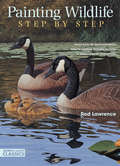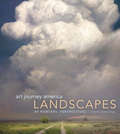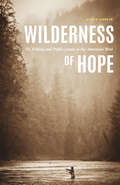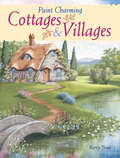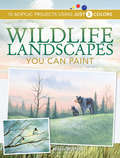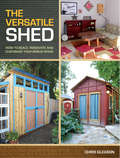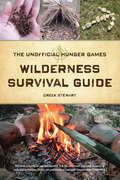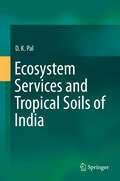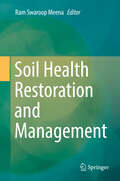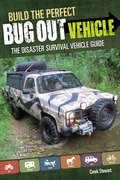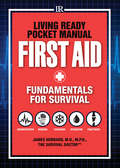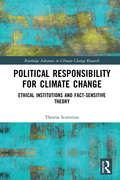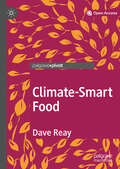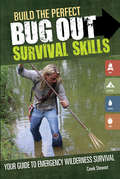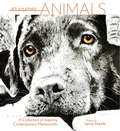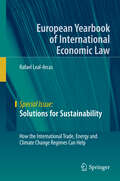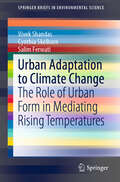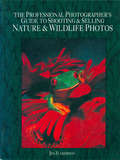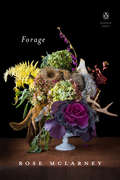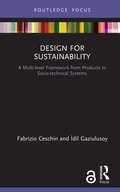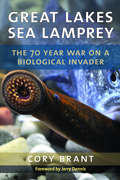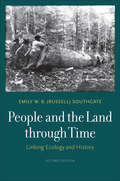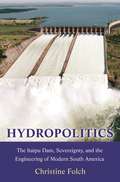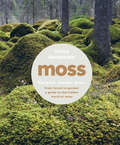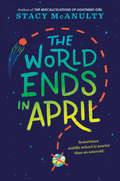- Table View
- List View
Painting Wildlife Step by Step: Learn from 50 demonstrations how to capture realistic textures in watercolor, oi l and acrylic
by Rod LawrenceEasy-to-follow, step-by-step demonstrations in acrylic, watercolor and oil Inside, you'll learn how to create realistic wildlife paintings, step by step, mastering dozens of specific wildlife textures, including: Fur of a bobcat, American bison, snow leopard cub and wolf Feathers of a wood duck, white-throated sparrow and northern shoveler Scales of a trout and sunfish Ears of a cottontail rabbit, white-tailed deer and red fox Bills and Muzzles of a northern cardinal, mallard, great blue heron and mountain lion Tails and Feet of a red squirrel, ruffled grouse and blue jay Antlers and Horns of a deer, moose, bighorn sheep and pronghorn White and Black Subjects such as a polar bear, tundra swan and Canada goose Through, you'll benefit from Rod Lawrence's years of wildlife painting experience. He'll help you notice, for example, the way hair and feature textures change on different parts of an animal's body through the seasons - and even according to the age of the animal. Use this heightened awareness, along with the easy-to-follow, step-by-step demonstrations inside, to create more realistic, more sensitive wildlife paintings.
Art Journey America Landscapes: 89 Painters' Perspectives (Art Journey)
by Kathy KippShowcasing the work of more than 100 top contemporary American master artists of our day, this book features landscapes (a popular subject for art collectors and a tradition throughout American art history) from all across the country-east and west, north and south-rendered in watercolor, oil, acrylic, pastel, colored pencil and mixed media. Accompanying each painting are the thoughts, techniques and inspirations for the paintings by each artist.
Wilderness of Hope: Fly Fishing and Public Lands in the American West (Outdoor Lives)
by Quinn GroverLongtime fly fisherman Quinn Grover had contemplated the “why” of his fishing identity before more recently becoming focused on the “how” of it. He realized he was a dedicated fly fisherman in large part because public lands and public waterways in the West made it possible. In Wilderness of Hope Grover recounts his fly-fishing experiences with a strong evocation of place, connecting those experiences to the ongoing national debate over public lands. Because so much of America’s public lands are in the Intermountain West, this is where arguments about the use and limits of those lands rage the loudest. And those loudest in the debate often become caricatures: rural ranchers who hate the government; West Coast elites who don’t know the West outside Vail, Colorado; and energy and mining companies who extract from once-protected areas. These caricatures obscure the complexity of those who use public lands and what those lands mean to a wider population. Although for Grover fishing is often an “escape” back to wildness, it is also a way to find a home in nature and recalibrate his interactions with other parts of his life as a father, son, husband, and citizen. Grover sees fly fishing on public waterways as a vehicle for interacting with nature that allows humans to inhabit nature rather than destroy or “preserve” it by keeping it entirely separate from human contact. These essays reflect on personal fishing experiences with a strong evocation of place and an attempt to understand humans’ relationship with water and public land in the American West.
Paint Charming Cottages & Villages
by Kerry TroutCapture the Charm of Cottage and Village ScenesBring the storybook cottages and towns of your dreams to life. Ten step-by-step projects show you how to paint a variety of architectural styles from a Victorian "gingerbread" house, to an English Tudor cottage, to a Cape Cod and a classic farmhouse. Two nostalgic village scenes take you back to simpler days of main streets lined with merchants, dress shops and tearooms.Dozens of quick mini-demonstrations show you how to embellish your scenes with quaint details, including porch swings, lace curtains, fountains, old-time lampposts, picket fences and quilts fluttering on a clothesline. You'll also learn how to add the seasonal touches of fall foliage, spring flowers and winter snows.Each project is painted with acrylic paints. Full-color photos, traceable patterns, color swatches, detailed materials lists and a techniques section make each painting easy to do. Use your paintbrush and these projects to create your own quaint getaway cottages today!
Wildlife Landscapes You Can Paint: 10 Acrylic Projects Using Just 5 Colors
by Wilson BickfordCapture the beauty and serenity of animals in natureIf you love nature and life's simpler things, you'll love painting with Wilson Bickford. In this book, with a teaching style as easy and inviting as his paintings, Wilson guides you step by step through ten charming wildlife scenes on canvas.Projects feature a variety of beloved animals including deer, black bears, blue herons, loons, ducks, swans and woodpeckersLearn to paint a range of breathtaking settings - sparkling lakes, majestic mountains, forest retreats and even atmospheric effects like hazy sunsets, snow-laden pines and rippling water.Includes mini-demonstrations that focus on key landscape elements such as trees, rocks, water and clouds.Each project includes color swatches showing which mix is used where and easy-to-follow directions.Simpler is always better when you're just starting out. These projects require minimal equipment, only five colors and absolutely no previous experience. Wilson loves to paint them - and with his friendly, straightforward approach, you will, too!
The Versatile Shed: How To Build, Renovate and Customize Your Bonus Space
by Chris GleasonSheds aren't just for storage anymore. With a little bit of thought and work, your shed can become a guest cottage, a recording studio, a writer's getaway and even a "small" business location. With more people staying in their current homes, the opportunity to add on beyond the scope of the existing house is more appealing than ever. The Versatile Shed offers basic how-to for building your own shed structure, along with recommendations for electrical and comfort needs. Also included are ideas for working with pre-fabricated sheds, with suggestions for customization. But mostly, this book is about ideas. With dozens of ideas for interior and exterior customization that will add an extra, and versatile, space to your home.
The Unofficial Hunger Games Wilderness Survival Guide: A Wilderness Skills Manual For Surviving The Arena
by Creek StewartPut the Odds in Your Favor! Train like a Tribute before you enter the Arena using this wilderness survival guide--you don't have to live in Panem to put these survival skills to use. Experience the adventure of life in District 12 by learning and practicing the survival skills used by Katniss, Peeta, Gale and their friends. Some of the survival skills you'll learn: Building temporary shelters to protect from rain, cold, wind and sun. Finding and purifying water--even when there are no streams or lakes nearby. Building and using fire for cooking, signaling, warmth and making tools. Identifying and cooking wild edible plants. Building Gale's famous twitch-up snares. Peeta's camouflage techniques. Katniss's hunting and stalking skills. Making your own survival bow and arrows and other tools. The materials you need to create a forage bag like Katniss's. Survival first aid. Navigation tips and tricks for travel, rescue and evasion. Detailed photos and step-by-step instructions will help you master each skill. The real-life skills found in The Unofficial Hunger Games Wilderness Survival Guide will help you in any wilderness or disaster survival situation. Start your training today.
Ecosystem Services and Tropical Soils of India
by D.K. PalThis book highlights ecosystem services of Indian tropical soils driven by soil properties. Soils are complex and important biomaterials and have an outstanding role in providing ecosystem services to mankind. The tropical soils have been traditionally and generally considered as either agriculturally poor or virtually useless by many. This book will discuss the difficulties encountered in managing Indian tropical soils in order to sustain their productivity. Some unique soil properties are yet to be linked explicitly to soil ecosystem services and soil care needs to be a constant research endeavour in the Indian tropical environment. This book highlights the new and unique soil knowledge base necessary to close the gap between food production and future population growth.
Soil Health Restoration and Management
by Ram Swaroop MeenaMeeting the food requirements of an ever-increasing population is a pressing challenge for every country around the globe. Soil degradation has a negative impact on food security by reducing the cultivated land areas, while at the same time the world population is predicted to increase to 9.2 billion in 2050. Soil degradation adversely affects soil function and productivity and degraded soils now amount to 6 billion ha worldwide. The major factors are salinization, erosion, depletion of nutrients due to exhaustive agricultural practices and contamination with toxic metal ions and agrochemicals, which reduces the activity of soil microbe. In addition, poor soil management also decreases fertility. As such, measures are required to restore the soil health and productivity: organic matter, beneficial microorganisms and nutrient dynamics can all improve the physical, chemical and biological properties of soil. Understanding the role of soil health restoration and management in sustainability and nutritional security calls for a holistic approach to assess soil functions and examine the contributions of a particular management system within a defined timescale. Further, best management practices in cropping systems are important in ensuring sustainability and food and nutritional security without compromising the soil quality and productivity potential. Rational soil management practices must allow environmentally and economically sustainable yields and restoration of soil health.
Build the Perfect Bug Out Vehicle: The Disaster Survival Vehicle Guide
by Creek StewartOutfit a Disaster-Escape Vehicle! If an unexpected disaster forces you to suddenly evacuate from your home, is your vehicle equipped to drive you to safety? It will be if you follow the advice in this book. Build the Perfect Bug Out Vehicle shows you how to outfit any vehicle with equipment and survival gear that will help you quickly drive from ground zero to a safer location. Survival expert Creek Stewart, author of the best-selling Build the Perfect Bug Out Bag, details from start to finish everything you need to equip an everyday vehicle for a drive through and away from disaster-stricken areas--from survival supplies and storage solutions to off-road travel, communication, navigation, and security considerations. You'll find: Practical and affordable Bug Out Vehicle equipment and principles that can be applied to any vehicle, even your everyday family car Photos and explanations of every item you need for your vehicle Resource lists to help you find and purchase gear You'll also find special considerations for bugging out using alternative modes of transportation including bicycles, boats, ATVS, motorcycles, horses, carts, aircraft and more. A disaster could strike your home at any moment. Don't be trapped in the devastating aftermath. Quickly transport yourself and your family to safety by building a Bug Out Vehicle today!
Living Ready Pocket Manual - First Aid: Fundamentals for Survival
by James HubbardSkills to Save A Life Whether you are miles from help or immersed in an urban disaster situation, every second counts during a medical emergency. This book will help you take quick, effective action to stabilize the situation. The easy-to-follow, step-by-step instruction in this book will help you prevent or respond to: Dehydration Hypothermia, frostbite and heatstroke Skin wounds including burns, cuts, bites and gunshots Anaphylaxis, allergic reactions and rashes Broken bones and injured joints Plus you'll find detailed packing lists for survival first aid kits of all sizes. This pocket-sized manual is perfect for packing in first aid kits, bug out bags, day-hiking packs and vehicle kits. Medical emergencies are unplanned and unpredictable, but you can be prepared. Arm yourself with knowledge that can save a life.
Political Responsibility for Climate Change: Ethical Institutions and Fact-Sensitive Theory (Routledge Advances in Climate Change Research)
by Theresa Birgitta ScaveniusThis book offers new perspectives on how social and political institutions can respond more effectively to climate change. Theresa Scavenius presents a concept of moral responsibility that does not address the obligations of individual citizens, but instead assesses the moral responsibility of institutionalised actors, such as governments, parliaments, and other governmental agencies. This focus on political responsibility is something that up until now has largely been neglected by moral theory, but Scavenius argues in this book that accountability must be assigned to institutionalised group agents. With this new research, she outlines building blocks for a new agenda of climate studies by offering an innovative approach to climate governance and democratic climate action at a time when many political initiatives have failed and crucially outlines the necessity of approaching moral dilemmas from a fact sensitive political theoretical approach. Written in a clear and engaging style, this volume will be an invaluable reference for researchers interested in moral philosophy, climate change, environmental politics and policy, and institutional theory.
Climate-Smart Food
by Dave ReayThis open access book asks just how climate-smart our food really is. It follows an average day's worth of food and drink to see where it comes from, how far it travels, and the carbon price we all pay for it. From our breakfast tea and toast, through breaktime chocolate bar, to take-away supper, Dave Reay explores the weather extremes the world’s farmers are already dealing with, and what new threats climate change will bring. Readers will encounter heat waves and hurricanes, wildfires and deadly toxins, as well as some truly climate-smart solutions. In every case there are responses that could cut emissions while boosting resilience and livelihoods. Ultimately we are all in this together, our decisions on what food we buy and how we consume it send life-changing ripples right through the global web that is our food supply. As we face a future of 10 billion mouths to feed in a rapidly changing climate, it’s time to get to know our farmers and herders, our vintners and fisherfolk, a whole lot better.
Build the Perfect Bug Out Survival Skills: Your Guide to Emergency Wilderness Survival
by Creek StewartLEARN HOW TO SURVIVE!When it comes to surviving a disaster, having survival skills and know-how is as essential as having the necessary survival gear. Without the right knowledge, survival gear is useless. Build the Perfect Bug Out Survival Skills will teach you the essential wilderness survival skills you need to endure a bug out situation or prolonged off-grid scenario. You will learn how to meet the four core survival needs - shelter, fire, water and food - with a minimum amount of equipment. Detailed photos and step-by-step instructions will help you master each skill.FEATURING:Detailed instructions for survival skills that require little gear - an emphasis on primitive toolsStep-by-step photos that clearly illustrate complex techniques like knot tying, shelter construction, fire building and setting snares and trapsAdvanced knowledge that could save you and your family during a real emergency
Art Journey Animals: A Collection of Inspiring Contemporary Masterworks (Art Journey)
by Jamie MarkleA Collection of Inspiring Contemporary Masterworks
Solutions for Sustainability: How the International Trade, Energy and Climate Change Regimes Can Help (European Yearbook of International Economic Law)
by Rafael Leal-ArcasThis book explores links and synergies between international trade and two of the most urgent challenges of the 21st century: achieving sustainable energy (i.e., energy that is affordable, secure, and clean) and mitigating climate change. It takes the unique approach of not only examining how international trade can help achieve energy and climate goals, but also the impact of emerging tools and technologies such as smart grids and demand response, and the potential role and impact of citizens and prosumers. The book analyzes energy- and trade-related regulations in a range of jurisdictions to assess how conducive the regulation is towards achieving sustainable energy, and identifies gaps and overlaps in the existing legal framework.
Urban Adaptation to Climate Change: The Role of Urban Form in Mediating Rising Temperatures (SpringerBriefs in Environmental Science)
by Vivek Shandas Cynthia Skelhorn Salim FerwatiThis book presents the findings of a three-year study on urban heat in Doha, Qatar, and discusses guidelines and strategies for planning agencies to consider in the context of moderating temperatures to provide pedestrians with greater access to outdoor spaces and greater choice in modes of transport. If modifying urban form can reduce extreme temperatures in one of the hottest places on the planet, then perhaps other communities can learn how to create livable cities during a time of rapid changes to the climate. In fact, despite the periods of extreme heat, strategic planning and management of urban areas can improve residents’ and visitors’ ability to live, work, and move throughout the city comfortably. Doha, Qatar, a city with one of the most extreme climates on earth, has undergone rapid development over the past 40 years. Although cities in the Middle East are expanding at three times the international average (UN Report, 2012), the rapid population and physical growth remain largely unexamined, particularly in terms of the unique conditions, qualities, and characteristics that give rise to these emerging centres. Speed, quality, and extent of urbanization impact neighbourhood-scale environmental conditions, and this book provides evidence that urban forms and materials can help to mediate temporal variation in microclimates and that landscape modifications can potentially reduce temperatures and increase accessibility to outdoor environments. By applying the lessons in this book, communities around the world can better adapt to the increasing frequency, duration and intensity of extreme heat.
The Professional Photographer's Guide to Shooting & Selling Nature & Wildlife Photos
by Jim ZuckermanWildlife and nature can be close to you as your backyard or the nearest zoo. In The Professional Photographer's Guide to Shooting & Selling Nature & Wildlife Photos, a professional photographer shows how to take fabulous wildlife and nature photographs and how to reach the best markets. More than 250 full-color photos include captions with detailed explanations of where and how each was shot and the easiest way to achieve the same effect.
Forage (Penguin Poets)
by Rose McLarneyA poet acclaimed for "uncompromising, honest poems that sound like no one else" (The Rumpus) now offers considerations of the natural world and humans' place within it in ecopoetry of both ambitious reach and elegant refinementRose McLarney has won attention as a poet of impressive insight, craft, and a "constantly questioning and enlarging vision" (Andrew Hudgins). In her third collection, Forage, she continues to weave together themes she loves: home, heritage, the South, animals, water, the environment. These intricately sequenced poems take up everything from animals' symbolic roles in art and as indicators of ecological change to how water can represent a large, troubled system or the exceptions of smaller, purer tributaries. At the confluence of these poems is a social commentary that goes beyond lamenting environmental degradation and disaster to record--and augment--the beauty of the world in which we live.
Design for Sustainability: A Multi-level Framework from Products to Socio-technical Systems (Routledge Focus on Environment and Sustainability)
by Fabrizio Ceschin İdil GaziulusoyThis book discusses the most significant ways in which design has been applied to sustainability challenges using an evolutionary perspective. It puts forward an innovation framework that is capable of coherently integrating multiple design for sustainability (DfS) approaches developed so far. It is now widely understood that design can and must play a crucial role in the societal transformations towards sustainability. Design can in fact act as a catalyst to trigger and support innovation, and can help to shape the world at different levels: from materials to products, product–service systems, social organisations and socio-technical systems. This book offers a unique perspective on how DfS has evolved in the past decades across these innovation levels, and provides insights on its promising and necessary future development directions. For design scholars, this book will trigger and feed the academic debate on the evolution of DfS and its next research frontiers. For design educators, the book can be used as a supporting tool to design courses and programmes on DfS. For bachelor’s and master’s level design, engineering and management students, the book can be a general resource to provide an understanding of the historical evolution of DfS. For design practitioners and businesses, the book offers a rich set of practical examples, design methods and tools to apply the various DfS approaches in practice, and an innovation framework which can be used as a tool to support change in organisations that aim to integrate DfS in their strategy and processes.
Great Lakes Sea Lamprey: The 70 Year War on a Biological Invader
by Cory BrantThe stuff of nightmares in both their looks and the wounds inflicted on their victims, sea lampreys (Petromyzon marinus) are perhaps the deadliest invasive species to ever enter the Great Lakes. At the invasion’s apex in the mid-20th century, harvests of lake trout (Salvelinus namaycush), the lampreys’ preferred host fish in the Great Lakes, plummeted from peak annual catches of 15 million pounds to just a few hundred thousand pounds per year—a drop of 98% in only a few decades. Threatening the complete collapse of the fishery, the sea lamprey invasion triggered an environmental awakening in the region and prompted an international treaty that secured unprecedented cooperation across political boundaries to protect the Great Lakes. Fueled by a pioneering scientific spirit, the war on Great Lakes sea lampreys led to discoveries that are the backbone of the program that eventually brought the creature under control and still protects the largest freshwater ecosystem in the world to this day. Great Lakes Sea Lamprey draws on extensive interviews with individuals who experienced the invasion firsthand as well as a trove of unexplored archival materials to tell the incredible story of sea lamprey in the Great Lakes—what started the invasion, how it was halted, and what this history can teach us about the response to biological invaders in the present and future. Richly illustrated with color and black & white photographs, the book will interest readers concerned with the health of the Great Lakes, the history of the conservation movement, and the ongoing threat of invasive species.
People and the Land through Time: Linking Ecology and History, Second Edition
by Emily W. SouthgateA revised and updated edition of a classic book that defines the field of historical ecologyPeople and the Land through Time, first published in 1997, remains the only introduction to the field of historical ecology from the perspective of ecology and ecosystem processes. Widely praised for its emphasis on the integration of historical information into scientific analyses, it will be useful to an interdisciplinary audience of students and professionals in ecology, conservation, history, archaeology, geography, and anthropology. This up-to-date second edition addresses current issues in historical ecology such as the proposed geological epoch, the Anthropocene; historical species dispersal and extinction; the impacts of past climatic fluctuations; and trends in sustainability and conservation.
Hydropolitics: The Itaipu Dam, Sovereignty, and the Engineering of Modern South America (Princeton Studies in Culture and Technology #20)
by Professor Christine FolchAn in-depth look at the people and institutions connected with the Itaipu Dam, the world’s biggest producer of renewable energyHydropolitics is a groundbreaking investigation of the world’s largest power plant and the ways the energy we use shapes politics and economics. Itaipu Binational Hydroelectric Dam straddles the Paraná River border that divides the two countries that equally co-own the dam, Brazil and Paraguay. It generates the carbon-free electricity that powers industry in both the giant of South America and one of the smallest economies of the region. Based on unprecedented access to energy decision makers, Christine Folch reveals how Paraguayans harness the dam to engineer wealth, power, and sovereignty, demonstrating how energy capture influences social structures.During the dam’s construction under the right-wing military government of Alfredo Stroessner and later during the leftist presidency of liberation theologian Fernando Lugo, the dam became central to debates about development, governance, and prosperity. Dams not only change landscapes; Folch asserts that the properties of water, transmuted by dams, change states. She argues that the dam converts water into electricity and money to produce hydropolitics through its physical infrastructure, the financial liquidity of energy monies, and the international legal agreements managing transboundary water resources between Brazil and Paraguay, and their neighbors Argentina, Bolivia, and Uruguay.Looking at the fraught political discussions about the future of the world’s single largest producer of renewable energy, Hydropolitics explores how this massive public works project touches the lives of all who are linked to it.
Moss: From Forest To Garden: A Guide To The Hidden World Of Moss
by Ulrica NordströmDiscover the secrets of moss Unassuming yet beautiful, moss has been used for centuries in gardens, medicine, and handicrafts around the world. It is most often associated with damp, shady spaces, but can be found in the most unexpected and far-flung places in the world, from deserts to Antarctica. Moss is Swedish writer and plant artist Ulrica Nordström’s celebration of this humble plant. Nordström introduces readers to the key varieties of moss and where they can be found, and tours some of the most beautiful moss gardens in Oregon, Sweden, and Japan, where moss-viewing has become a national phenomenon. She also teaches readers how to identify and gather different moss species, cultivate moss, tie Japanese moss balls (kokedama), and plant moss landscapes in pots and terrariums. With stunning photography and botanical illustrations, this unique book will be treasured by plant lovers of all kinds.
The World Ends in April
by Stacy McAnultyIs middle school drama scarier than an asteroid heading for Earth? Find out in this smart and funny novel by the author of The Miscalculations of Lightning Girl. <P><P>Every day in middle school can feel like the end of the world. <P><P>Eleanor Dross knows a thing or two about the end of the world, thanks to a survivalist grandfather who stockpiles freeze-dried food and supplies--just in case. So when she reads about a Harvard scientist's prediction that an asteroid will strike Earth in April, Eleanor knows her family will be prepared. Her classmates? They're on their own! <P><P>Eleanor has just one friend she wants to keep safe: Mack. They've been best friends since kindergarten, even though he's more of a smiley emoji and she's more of an eye-roll emoji. They'll survive the end of the world together . . . if Mack doesn't go away to a special school for the blind. <P><P>But it's hard to keep quiet about a life-destroying asteroid--especially at a crowded lunch table--and soon Eleanor is the president of the (secret) End of the World Club. It turns out that prepping for TEOTWAWKI (the End of the World as We Know It) is actually kind of fun. But you can't really prepare for everything life drops on you. And one way or another, Eleanor's world is about to change.
